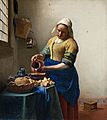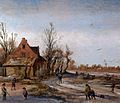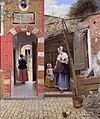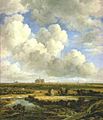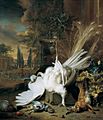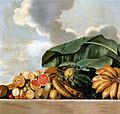Dutch Golden Age painting facts for kids
The 17th century was a very special time for the Dutch. During this period, their trade, science, and art were among the best in all of Europe. This amazing time is known as the Dutch Golden Age. It began around the second half of the Eighty Years' War. After the war, the Dutch Republic became the richest country in Europe. The art style of this time was called Baroque. Many Baroque paintings made scenes look prettier than they really were. This is called 'idealisation'. But Dutch paintings from this time often showed things more realistically. Famous artists from this period include Johannes Vermeer, Peter Paul Rubens, Bartholomeus van der Helst, and Jacob van Loo.
Contents
Art for Everyday Life
During the Dutch Golden Age, there were not many paintings about religious stories. This was because most Dutch people followed Calvinism. This religion did not allow religious paintings in churches. Even though religious art was okay for homes, it was not very popular.
Instead, Dutch artists painted many other kinds of scenes. They painted portraits of people and historical events. But they were most famous for many other types of art. These included:
- Scenes of everyday life, like people working or playing.
- Beautiful landscapes and townscapes (pictures of cities).
- Landscapes with animals.
- Paintings of ships and the sea (maritime paintings).
- Bright flower paintings.
- And different kinds of still lifes, which are paintings of objects.
Dutch artists from the 17th century greatly influenced how these types of paintings developed.
What Paintings Were Most Important?
There was a belief in the art world that some types of paintings were more important than others. This idea was called the hierarchy of genres. At the very top of this list was history painting. These paintings showed important events from history, myths, or the Bible. Because history painting was seen as the most important, many artists wanted to create them.
However, historical paintings were often the hardest to sell. To earn a living, many painters had to create portraits or scenes of everyday life. These sold much more easily. The list of importance went like this:
- History painting: These included stories from history, myths (called allegories), and popular religious scenes.
- Portrait painting: Pictures of people, including a special type called a tronie. A tronie was a painting of a face or head, often with an exaggerated expression or costume.
- Genre painting: Scenes showing everyday life.
- Landscape: Paintings of nature, including seascapes, battle scenes, city views, and old ruins.
- Still life: Paintings of objects like fruit, flowers, or household items.
Dutch artists focused a lot on the "lower" categories, but they still understood the idea of this hierarchy.
How Paintings Were Made
Most paintings from this time were quite small. The only common large paintings were group portraits, like those of city guards. Painting directly onto walls was very rare. If a public building needed art on a wall, artists usually used a framed canvas that fit the space.
Many painters continued to use wooden panels for their art. This allowed for extra precision and detail. Other parts of Europe had stopped using panels by then. Some Dutch artists even used copper plates, often recycling them from printmaking.
Sadly, many Golden Age paintings were painted over in the 18th and 19th centuries. A new painting on an old canvas was often cheaper than buying new materials.
There was not much Dutch sculpture during this period. Most sculptures were found on tomb monuments or public buildings. Small sculptures for homes were rare. Instead, people had beautiful silverware and ceramics. Painted delftware tiles were very common and cheap. But Dutch silver, especially in the fancy auricular style, was famous across Europe. Overall, the best artistic efforts in the Netherlands were put into painting and printmaking.
Gallery
-
Frans Hals' tronie, with the later title Gypsy Girl. 1628-30. Oil on wood, 58 cm × 52 cm (23 in × 20 in). The tronie includes elements of portraiture, genre painting, and sometimes history painting.
-
Paulus Potter, The Young Bull (1647); 3.4 metres wide. An unusually monumental animal painting that challenges the hierarchy of genres.
Images for kids
-
Johannes Vermeer, The Milkmaid (1658–1661)
-
The Blinding of Samson, 1636, which Rembrandt gave to Huyghens
-
Utrecht Caravaggism: Dirck van Baburen, Christ crowned with thorns, 1623. This was painted for a convent in Utrecht.
-
Frans Hals, Willem Heythuijsen (1634), 47 cm × 37 cm (19 in × 15 in).
-
The Meagre Company, an Amsterdam militia group portrait or schutterstuk by Frans Hals and Pieter Codde (1633-37)
-
A typical Jan Steen picture (c. 1663). While the housewife sleeps, the household plays.
-
Jacob van Ruisdael, The Windmill at Wijk (1670)
-
Aelbert Cuyp, River landscape with Riders (c. 1655). Cuyp was known for golden evening light in Dutch settings.
-
Pieter Jansz Saenredam, Assendelft Church, 1649. The gravestone of his father is in the foreground.
-
Pieter Claesz, Vanitas (1630). A vanitas painting reminds us that life is short.
-
Frans Post, scene in Dutch Brazil. Painted in 1662, some years after the colony was lost.
-
Pieter de Hooch, Courtyard of a House in Delft, 1658. A study of home life, textures, and complex spaces. The woman is a servant.
-
Judith Leyster, A Boy and a Girl with a Cat and an Eel. This painting might refer to old sayings or symbols.
-
Nicolaes Maes, The idle servant. Problems with housemaids were a subject in several of Maes' works.
-
Jacob van Ruisdael, View of Haarlem. Ruisdael was a very important landscape painter, with more varied subjects than many others.
-
Jan van Goyen, Dune landscape. An example of the "tonal" style, using soft colors.
-
Willem van Aelst, Still life with a watch (c. 1665), with a typical dark background.
-
Willem Claeszoon Heda, Breakfast Table with Blackberry Pie (1631). Heda was famous for painting shiny surfaces.
-
Jan Davidszoon de Heem, Vanitas (1629). A vanitas painting reminds us about life and death.
-
Landscape with sugar mill, Frans Post
-
Landscape with a worker's house, Frans Post
-
Bananas, goiaba, and other fruits, Albert Eckhout
See also
 In Spanish: Pintura del Siglo de oro neerlandés para niños
In Spanish: Pintura del Siglo de oro neerlandés para niños





